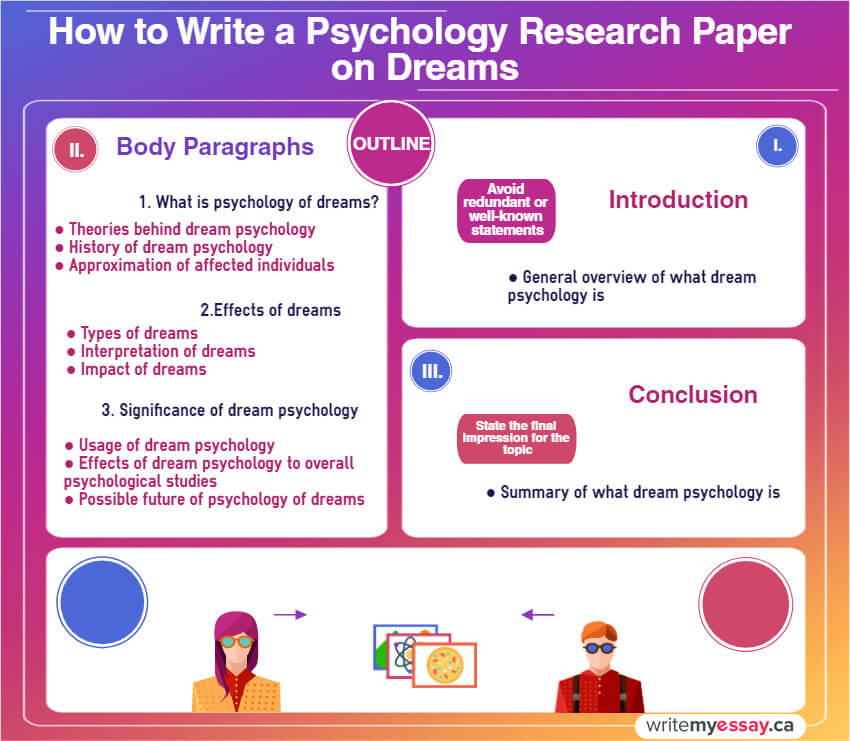
How to Write a Psychology Research Paper on Dreams

Table of Contents
Psychology Research Paper on Dreams

- How to start
- Outline sample
- How to write the introduction
- How to write the thesis statement
- Thesis statement example
- Introduction example
- How to write body paragraphs
- Example of the 1st body paragraph
- Example of the 2nd body paragraph
- Example of the 3rd body paragraph
- How to finish the research paper
- Example of the conclusion
- Research paper revision
Research papers are essential tools for students to pass academic demands. Now, given the scenario that a student was tasked to write a paper about dreams from the psychology perspective but she was not an undergraduate of the program itself, she inevitably had a difficult time choosing what to write about. She was aware that the topic itself already had a lot of previous articles written about it but alas, even with her awareness she has yet to write down her own ideas. So, to avoid further confusion, she decided to follow these simple steps on how to write a paper about dream psychology.
How to start
Preliminary research on definitions, analysis, etc. should be done first when writing about dream psychology since that will help them start out their papers. As an undergraduate, the author’s priority is to know what dreams are and how they should be related to psychology. Moreover, the essay writer may also research peer-written papers so that she may have an idea on how to write her own paper since those types of papers can act as a guide.
When she is done with her preliminary research, the student must now do her extensive research based on her preferred ideas. A good way of doing this is to list down three main ideas and find out related articles to approximately three to five sub-points or sub-ideas and then another three to five to act as supporting points. Since the topic is about dream psychology, the author may write about how dream psychology had affected individuals who claim that they had repeatedly experienced this phenomenon or how dream psychology contributes to the overall psychological studies of a person.
Outline sample
To write the outline, the student must take into account that it has to be short but give a complete elaboration on what to expect in the paper and that it should be neatly organized. The outline must also be divided into the introduction, body, and conclusion sections.
I. INTRODUCTION
- General overview of what dream psychology is
II. What is a psychology dream
- Theories behind dream psychology
- History of dream psychology
- Approximation of affected individuals
III. Effects of dreams
- Types of dreams
- Interpretation of dreams
- Impact of dreams
IV. Significance of dreams psychology
- Uses of dream psychology
- Effects of dream psychology to overall psychological studies
- Possible future uses of dream psychology
V. Conclusion
The outline plays an integral role in making sure that the student is able to neatly write their research paper. The outline may also serve as early corrections when the writer wants to change her ideas in the paper.
How to write the introduction
Though the introduction can be written in a variety of ways, it must always grab the attention of the audience for them to keep on reading up until the end. Below is a list of tips and tricks on how the writer can create an introduction.
- Start off with a hook
A hook sentence comes in many forms: an anecdote for an illustration so that the writer can get her point across, a dialogue between two people, an information summary to discuss the overall topic of the paper (briefly), and information that is startling enough that the readers would want more of how the paper went.
The student must be wary that not all audiences will be specializing in dream psychology or are not even psychologists at all so she must be wary on simplifying this part of the paper.
- Use relevant information
- Avoid redundant or well-known statements
- State the reason why the readers should read the paper
This is the critical part of the introduction in which the author must be able to sell their paper to the audience. Basically, this is hook-line-and-sinker and this will all depend on how good the hook sentences, as well as the thesis statement, are.
How to write the thesis statement
The thesis statement serves as the principal core of the research paper and it should be written strongly so the main idea is palpable. The thesis should also be written in a clear and should be self-explanatory at its finest so the use of vague words is a big NO.
Thesis statement example
To better understand this dream psychology, an analysis of what is dream psychology, its effects and significance will be made.
Introduction example
The psychology of dreams continues to be a well-known topic not just for its contribution to overall psychology but also to its contribution to the other aspects of medical field such as endocrinology. Dream psychology is also controversial in itself as it continues to be a debate as to whether or not that dreaming is a means for the mind to work on the complexity of personality. To better understand dream psychology, an analysis of what is dream psychology, its effects and significance will be made.
How to write body paragraphs for the research paper
Writing the body paragraphs follow steps much like how to write the introduction and the conclusion:
- Write main ideas which explain the thesis statement
- Write down supporting points to explain the main ideas
- Elaborate the supporting points by basing them on facts
- Include a summary of each paragraph (optional but it is recommended)
- Review the body paragraphs for any errors in citations
Though this can be done in the revision stage, as early as the first body paragraph, it is best to review for any errors already since the author is writing about a research paper to avoid the lengthier work of re-searching once again for the source material.
Example of the 1st body paragraph
Dreams psychology is a means to interpret dreams by drawing out their meaning. In general, dreams psychology is also known as Oneirology. Dreams usually occur during the REM stage of sleep or the rapid-eye-movement since brain activity at this stage is high and that the unconscious individual may also be seen as a conscious person. Though the psychology of dreams was not a new topic back in the early 1900s, it was Sigmund Freud who was able to explain and extensively write about dream psychology theories and interpreted them.
Example of the 2nd body paragraph
There are several types of dreams experienced by individuals. Behind these types of dreams, there are different interpretation and impacts on the individual themselves. The types of dreams include daydreams, lucid dreams, healing dreams, prophetic dreams, nightmares, signal dreams, recurring and epic dreams. Among the eight types of dreams, the most prominent ones are lucid dreaming and nightmares and this can be explained through the ability of the individual to be able to control their dreams and for their nightmares which may also end up recurring or can even be prophetic at times.
Example of the 3rd body paragraph
Dream psychology continues to play a significant role in the psychoanalysis of a person overall. Dream psychology is used as an interpretative tool for individuals suffering complex mental conflicts and sometimes disorders through so that psychologist may have a better understanding on what makes an individual them and how the psychologist would be able to interact, help and guide them upon consultation for their service. It is possible that in the near future, the animation, as well as dream recording, would be possible for individuals so that they may know what went on in their state of unconsciousness and will also help raise awareness of what that individual went through for psychologists, medical professionals and those who care for the individual.
How to finish the paper
If you want to develop a good conclusion, elements of the following can (recommended) be included:
- Restate the thesis statement
- Summary of all points
- Discuss possible topics in the future
- State the limitations of the paper
- State the final impression for the topic
The conclusion usually has three to four sentences.
Example of the conclusion
Dream psychology continues to be a tool that is used by psychologists for the interpretation of dreams and to explain the complexity of the mind of an unconscious person. Though this paper is limited to the interpretation of dreams based on a psychological perspective, dream psychology may also be able to explain diseases such as pancreatitis so as such, future studies of dream psychology and its correlation with medical diseases are advised. Overall, dream psychology is an indispensable tool for the endless interpretation and deciphering of the minds of an individual.
Research paper revision
Since this type of research paper states not only an opinion but factual points, consultation with experts or those knowledgeable in the field is a must to verify whether or not the student was able to use the right source materials and if the proper citation was done. When the student is done with the consultation, proper editing and revisions must be done for grammatical, punctuation, and spelling errors should be conducted before submitting the work.
Reference:
- Freud, S. & Eder, M.D. (2005) Dream psychology; Psychoanalysis for Beginners. New York: James A. McCann Co, 1920. ISBN13: 9781595690166.


